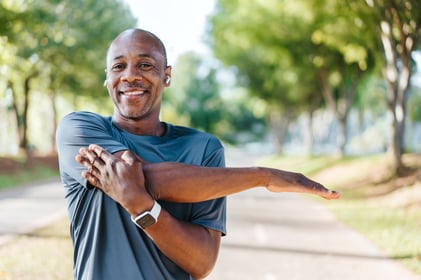 Staying active and making healthy choices is important, especially as we get older. Strength training and maintaining a healthy body composition can make a big difference in how we move, look, and feel as we age.
Staying active and making healthy choices is important, especially as we get older. Strength training and maintaining a healthy body composition can make a big difference in how we move, look, and feel as we age.
Understanding Body Composition
Body composition is the balance of muscle, fat, bone, and other tissues in your body. As we get older, this balance tends to shift. Without regular exercise, body fat usually increases, and muscle mass can start to decrease. This change can impact your health and increase disease risks.
Muscle loss, known as sarcopenia, often starts in your 40s and speeds up with age. At the same time, fat storage—especially around the belly—can increase, even if your weight stays the same. This shift in body composition can slow your metabolism, making it easier to gain fat. Hormonal changes, such as lower testosterone and estrogen levels, also contribute to these changes.
Why Strength Training Matters
Strength training, or resistance training, involves exercises that use weights, resistance bands, or body weight to strengthen muscles. It’s one of the best ways to combat age-related body changes. Here are some key benefits of strength training as you age:
- Maintains and Builds Muscle: Strength training can help you prevent muscle loss and even build new muscle.
- Increases Metabolism: Muscle burns more calories than fat, even at rest, so by building muscle, you’re boosting your calorie burn all day.
- Helps Burn Fat: Strength training not only builds muscle but also helps burn fat by raising your metabolism.
- Strengthens Bones: Lifting weights improves bone density, which reduces the risk of osteoporosis.
- Improves Balance and Flexibility: Strong muscles around your joints help you stay steady and can reduce the risk of falls.
- Lowers Chronic Disease Risks: Strength training can decrease the risk of diabetes, heart disease, and arthritis.
Adjusting Your Strength Training Routine by Age
As you age, your strength training goals may change. Here’s a general guide for each stage:
- 40s: Focus on maintaining muscle and preventing early muscle loss. Include exercises like squats, lunges, and deadlifts to build strength. If you’re new to strength training, start slowly and increase intensity gradually.
- 50s and 60s: Prioritize functional strength and flexibility. Exercises that improve balance, such as planks and resistance band work, are especially helpful. Make time for recovery and add stretching or yoga for flexibility.
- 70s and Beyond: In your 70s and beyond, it’s all about maintaining independence and supporting everyday movements. Light weights, resistance bands, and bodyweight exercises are ideal. Listen to your body, and make adjustments to stay safe and comfortable.
Additional Tips to Support Muscle Mass
- Eat Enough Protein: Protein helps your muscles repair and grow, especially after workouts. Foods like lean meat, fish, beans, and eggs are excellent sources.
- Stay Hydrated: Hydration keeps your muscles working well, so be sure to drink enough water daily.
How to Start a Strength Training Routine
If you’re new to strength training, start with bodyweight exercises, light weights, or resistance bands. As you gain confidence, you can increase the weight or number of reps. Set realistic goals and track your progress to stay motivated. Consistency is key—strength training provides benefits that build over time. For personalized support, visit your onsite NIFS fitness center, where our staff can help you get started!
Strength training is one of the best ways to improve body composition and support your health as you age. It’s never too late to start, and by making it a regular part of your routine, you can set yourself up for a stronger, healthier future.


 T
T At the
At the 
 Exercise can affect our digestive system in many ways, mostly yielding beneficial results but occasionally leading to digestive discomfort if done incorrectly. Factors like meal timing, meal composition (amount of fat, protein, and carbs), exercise intensity, and duration all play a role. For instance, a high-fat meal before intense exercise may lead to digestive discomfort, but if the meal is given enough time to digest, it can actually improve exercise performance. So, how can exercise specifically aid digestion?
Exercise can affect our digestive system in many ways, mostly yielding beneficial results but occasionally leading to digestive discomfort if done incorrectly. Factors like meal timing, meal composition (amount of fat, protein, and carbs), exercise intensity, and duration all play a role. For instance, a high-fat meal before intense exercise may lead to digestive discomfort, but if the meal is given enough time to digest, it can actually improve exercise performance. So, how can exercise specifically aid digestion? ‘
‘ Time is our most precious, valuable, non-renewable resource. And we’re all running out of it. B
Time is our most precious, valuable, non-renewable resource. And we’re all running out of it. B November marks COPD Awareness Month, a time to raise awareness of Chronic Obstructive Pulmonary Disease (COPD), a condition affecting millions worldwide. COPD is a chronic lung disease that makes it hard for air to move in and out of the lungs, making it hard to breathe. With COPD, everyday tasks can feel challenging, leaving many breathless and less motivated to stay active. While COPD is irreversible, regular exercise can help manage symptoms and improve quality of life.
November marks COPD Awareness Month, a time to raise awareness of Chronic Obstructive Pulmonary Disease (COPD), a condition affecting millions worldwide. COPD is a chronic lung disease that makes it hard for air to move in and out of the lungs, making it hard to breathe. With COPD, everyday tasks can feel challenging, leaving many breathless and less motivated to stay active. While COPD is irreversible, regular exercise can help manage symptoms and improve quality of life.
 In the golden years of life, one's perspective becomes a cherished companion, guiding the way through memories and new experiences. The importance of perspective for senior citizens cannot be overstated. It can shape the quality of their lives, influence well-being, and contribute significantly to a fulfilling and joyous retirement. In this blog, we'll delve into the significance of perspective for seniors and explore how cultivating a positive outlook can enhance their overall happiness and life satisfaction.
In the golden years of life, one's perspective becomes a cherished companion, guiding the way through memories and new experiences. The importance of perspective for senior citizens cannot be overstated. It can shape the quality of their lives, influence well-being, and contribute significantly to a fulfilling and joyous retirement. In this blog, we'll delve into the significance of perspective for seniors and explore how cultivating a positive outlook can enhance their overall happiness and life satisfaction. 
 Picture this: You're gliding effortlessly across a small trampoline, the rhythmic bouncing sending a gentle wave of energy through your body. This isn't just some childhood fantasy; it's rebounding, a low-impact exercise gaining popularity among senior citizens for its myriad health benefits.
Picture this: You're gliding effortlessly across a small trampoline, the rhythmic bouncing sending a gentle wave of energy through your body. This isn't just some childhood fantasy; it's rebounding, a low-impact exercise gaining popularity among senior citizens for its myriad health benefits.
 I call this the "Awakening." Simply put, you are realizing that your body is feeling the wear and tear of life to this point. It’s that realization that at 40 years old, you shouldn't move through life like you're 20. The point at which an individual becomes self-aware of these aches and pains varies from person to person. Some people don’t have substantial damage to their body and can probably make it well past their 20s before being bothered. My experience, like a lot of other athletes I've talked to, is one where we start to feel the damage a bit earlier than expected. It's like a car that is supposed to be driven ten thousand miles a year but is instead driven twenty thousand. The good part of the awakening process is that it is your call to action!
I call this the "Awakening." Simply put, you are realizing that your body is feeling the wear and tear of life to this point. It’s that realization that at 40 years old, you shouldn't move through life like you're 20. The point at which an individual becomes self-aware of these aches and pains varies from person to person. Some people don’t have substantial damage to their body and can probably make it well past their 20s before being bothered. My experience, like a lot of other athletes I've talked to, is one where we start to feel the damage a bit earlier than expected. It's like a car that is supposed to be driven ten thousand miles a year but is instead driven twenty thousand. The good part of the awakening process is that it is your call to action!